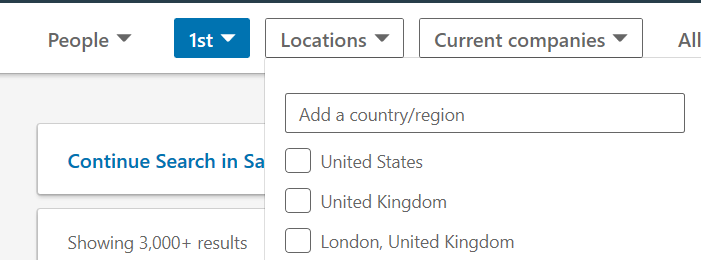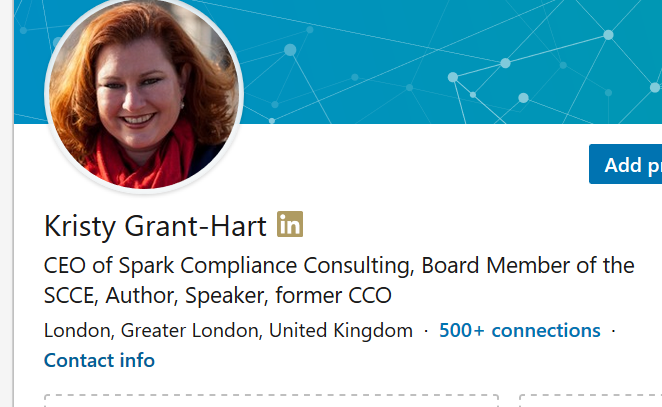10 Ways to Look for (and Get!) a New Job
/There’s a churn going on…in the last month, I’ve received more calls from people who are ready to move up, choosing to leave, been made redundant/fired, or are simply unhappy at their companies looking for a new role than I have ever had since I started Spark Compliance Consulting. Need to know how to get a new gig fast? Great. Not looking now? That’s OK – these actions will always help you in your career progression. Here are ten ways to look for (and get!) a new job.
1. Review Your LinkedIn Contacts in Your Area
LinkedIn is always your best friend when it comes to looking for a job. What you may not know is that you can find all of the local compliance folks in your area so you can ask them to coffee or meet up to talk compliance. When you do so, you can see if they have, or know of, any openings locally. How do you do this?
Go to the “My Network Tab.” On the left-hand side of the screen under “Manage My Network,” click “Connections.” Then click “Search with Filters.” At the top of the screen, you’ll see “People,” then “Locations.” From there you’ll get a drop-down that allows you to type in your city’s location.
Connect with your first-level connections by either messaging them directly in the LinkedIn messaging app, or email them if their email address is on LinkedIn. You can see the email address with which they signed up on LinkedIn by clicking on the person’s profile, then looking at the “Contact Info” link.
The person’s email will come up. If it’s a business email address – great! If it’s a personal email address, you’re probably better off using the LinkedIn messenger.
Once you’ve found a way to contact your connection, set up a quick get-together. Most compliance professionals are looking to strengthen their network, especially in their community. You’ll be adding to the profession while making it more likely that you’ll hear about open positions.
2. Find Your Local Compliance Groups and Join
Chances are good that if you’re in or near a city, there’s a local compliance group. Find out from your contacts whether such a group exists. If the group exists, join it, or go as a guest. This is a great place to find out about opportunities.
3. Start Writing: Blogs and Articles
One of the people I spoke with this week said that she had seen an overflow of jobs requiring a strong understanding of third-party due diligence and risk management. I immediately suggested she write a blog about best practices for third-party due diligence. Once she’s got the blog published, she can forward the link or create a PDF of the article to include with her resume submissions. This tactic creates numerous benefits. First, it shows subject matter expertise in a way a CV by itself cannot. Secondly, it shows the reviewer your writing capacity, which is a critical skill in the compliance profession.
You can submit a blog to me (kgranthart@sparkcompliance.com), as Compliance Kristy occasionally posts other people’s work. You can also submit a blog piece to the Compliance and Ethics blog (submission instructions HERE). There are other blogs and magazines you can submit to in the compliance space as well. Having a published article or blog post, especially one showcasing your best skills, can be worth its weight in gold.
4. Track Down Conference Attendees from Conferences Past
Did you go to a conference last year at any time? Dig out your emails – many conferences provide attendee lists with contact information. It’s pretty easy to contact someone who attended a conference with you about a session at the conference, then ask if they have time to talk about that topic with you. Reintroducing yourself to someone you have met or been with at a conference is much easier than cold-calling someone you haven’t met. What if no contact list was provided? Try asking the conference creators/organizers for the list. All they can say is no.
5. Review the SCCE/HCCA Job Boards
Many companies pay a placement fee to have the Health Care Compliance Association (HCCA) and/or the Society of Corporate Compliance and Ethics (SCCE) post their jobs. The associations send out emails to members, or you can access the job boards HERE (HCCA) and HERE (SCCE).
6. Present a Webinar
The HCCA and SCCE sponsor webinars multiple times per month – sometimes multiple times per week. Why not submit a proposal to present a webinar? (submit HERE for SCCE and HERE for HCCA) Preparing the materials for a webinar will undoubtedly sharpen your skills in the area about which you’re speaking. If you choose a subject that is in-demand in compliance space you wish to move into, you’ll be showing the world (and hiring managers) that you know your stuff.
7. Check Radical Compliance’s Job Report
The wonderful Matt Kelly writes a blog called Radical Compliance (see HERE). He frequently publishes his Compliance Jobs Report (see the latest edition HERE). Why not peruse the jobs report to see which companies people have left? If someone’s left, there may very well be a vacancy that you can jump into. Also, look at the report to see if the hiring company is expanding its compliance department. Many companies hire multiple roles in compliance at once when they are beefing up their team.
8. Find a Specialist Recruiter
The compliance world is different from other types of hiring. There are specialist recruiters that help to find people jobs in the compliance and ethics space. Many of these recruiters work with in-house legal professionals as well, so if you can’t find a specialist recruiter in your area, look for one that places lawyers and legal teams. Some well-known examples of specialist recruiters with a compliance specialty include Baron Crawford in London (HERE), Barker Gilmore (HERE), Conselium (HERE), and Laurence Simons (HERE).
9. Look on the LinkedIn Jobs Page
LinkedIn maintains a robust job page. The breadth of LinkedIn’s reach means that you’ll see plenty of jobs. On the downside, this means that there may be many more people applying than there would be if you found the opening through your network or a specialist recruiter. Nevertheless, it pays to cast a wide net. Find the LinkedIn job board HERE.
10. Update Your Resume/CV
While you’re on LinkedIn, be sure to update your resume/CV with your latest achievements. More information is generally better, so add in all of your accomplishments. Think broadly about what you’ve done, and don’t be afraid to show off. No one will know how great you are unless you ensure they can easily discover it for themselves. Take the changes you’ve made to your online profile and update your standard resume with them to ensure your resume is up-to-date.
If you employ even one of these methods, you’re likely to get to the next level fast. Employ two or three, and the phone should be ringing quickly. Whether you want to leave or have to leave your current job, there’s always another place for your talents. Trust that you’re on the path that you’re supposed to be on, and in no time, you’ll find your way.









